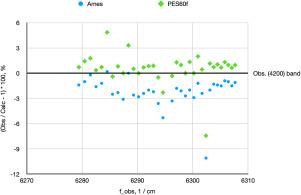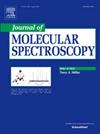利用Radau坐标和精确势能面计算14N2 - 16O线强度
IF 1.3
4区 物理与天体物理
Q4 PHYSICS, ATOMIC, MOLECULAR & CHEMICAL
引用次数: 0
摘要
用DVR3D核运动软件计算了14N2 16O分子的谱线强度。最近,我们(Mizus et al., JQSRT, 344, 109463(2025))提出了一个与经验能级拟合的势能面(PES),精度接近0.002 cm−1,以及使用MRCI(多参考配置相互作用)理论从头开始计算的非常精确的偶极矩面(DMS)。然而,这些精确的PES和DMS并没有产生均匀准确的计算线强度:一些过渡强度与测量值有数量级的差异。在这里,我们分析了这些不准确计算线强度的原因,并开发了一个光谱模型,该模型给出了一贯准确的强度预测。这一改进是基于PES精度的相对较小的改进,通过将计算中使用的内部坐标从Jacobi改为Radau来强调这一需要。特别是,新模型预测的线强度与实验精度接近,这些振动带,即(v1v2, v3)等于(5000),(4200),(3200)和(0112),其强度测量精度低于百分之一。本文章由计算机程序翻译,如有差异,请以英文原文为准。

Calculated 14N2 16O line intensities using Radau coordinates and an accurate potential energy surface
Line intensities of the molecule are calculated using the DVR3D nuclear-motion program suite. Recently, we (Mizus et al., JQSRT, 344, 109463 (2025)) presented a potential energy surface (PES) fitted to empirical energy levels with an accuracy close to 0.002 and very accurate dipole moment surfaces (DMS) calculated ab initio using a MRCI (multi-reference configuration interactions) level of theory. However, these accurate PES and DMS did not yield uniformly accurate calculated line intensities: some transition intensities disagreed with the measured ones by orders of magnitude. Here we analyze the reasons for these inaccurately calculated line intensities and develop a spectroscopic model which gives consistently accurate intensity predictions. This improvement is based on a relative minor improvement in the accuracy of the PES, the need for which was highlighted by changing the internal coordinates used in the calculation from Jacobi to Radau. In particular, the new model predicts line intensities with close to experimental accuracy for those vibrational bands, namely () equals (5000), (4200), (3200) and (0112), whose intensities have been measured with sub-percent accuracy.
求助全文
通过发布文献求助,成功后即可免费获取论文全文。
去求助
来源期刊
CiteScore
2.70
自引率
21.40%
发文量
94
审稿时长
29 days
期刊介绍:
The Journal of Molecular Spectroscopy presents experimental and theoretical articles on all subjects relevant to molecular spectroscopy and its modern applications. An international medium for the publication of some of the most significant research in the field, the Journal of Molecular Spectroscopy is an invaluable resource for astrophysicists, chemists, physicists, engineers, and others involved in molecular spectroscopy research and practice.

 求助内容:
求助内容: 应助结果提醒方式:
应助结果提醒方式:


